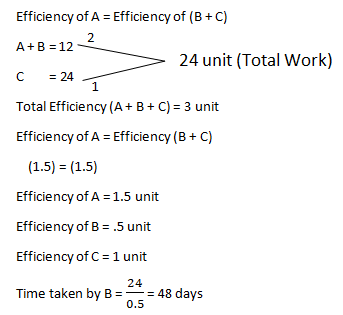Question
A can do a certain work in the same time in which B and
C together can do it. If A and B together could do it in 12 days, and C alone in 24 days, in what time could B alone do it?Solution

What was the main objective of the Industrial (Development and Regulation) Act, 1951 in India?
The process of globalisation is not handled by which of the following organisations?
The assumption that "man is selfish and self-centered, and always tries to achieve his own ends even at the cost of others" explains which theory of la...
Which bridge was inaugurated by Prime Minister Narendra Modi on 24 February 2024 to connect Dwarka in the Gulf of Kutch region ?
A farmer divides his herd of n cows among his four sons so that the first son gets one – third the herd, the second son gets one – fifth, the third ...
Consider the following statements:
(1) Article 21 talks about the protection of life and personal liberty.
(2) Article 21 is a part of t...
What is the minimum number of states required in a Turing Machine to recognize the language L = { aⁿbⁿ | n ≥ 1 }?
Consider the following statements:
1. Biofilms can form on medical implants within human tissues.
2. Biofilms can form on food and food pr...
Bio-remediation is a technology which is being extensively utilized in controlling
Match List-1 (Person) with List-II (Organization) and select the correct answer using the code given below the lists:
List-I (Person)



